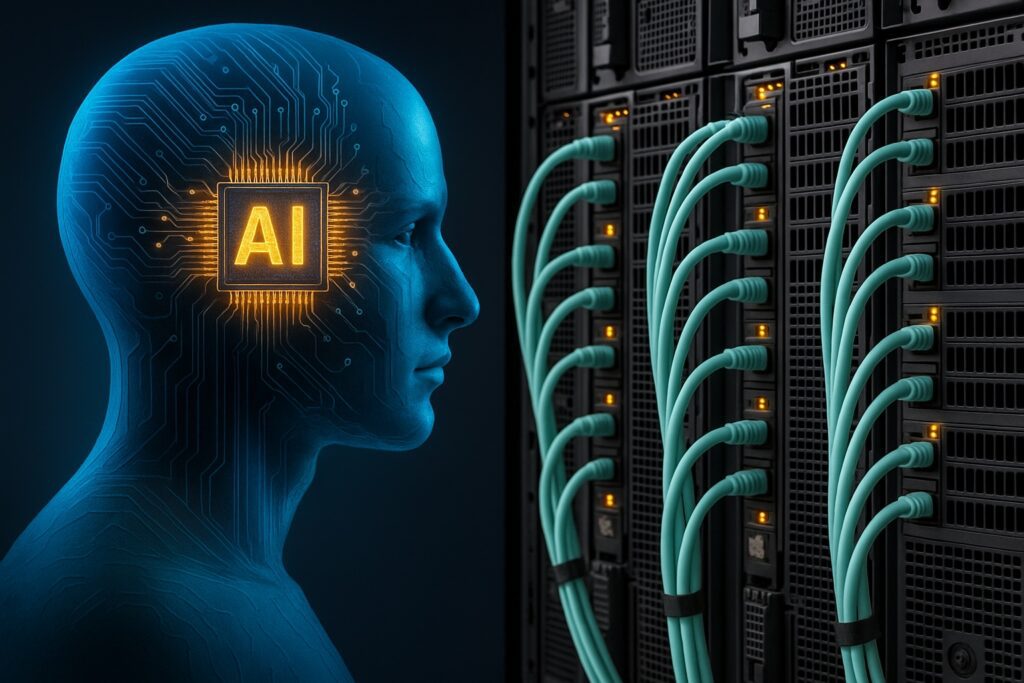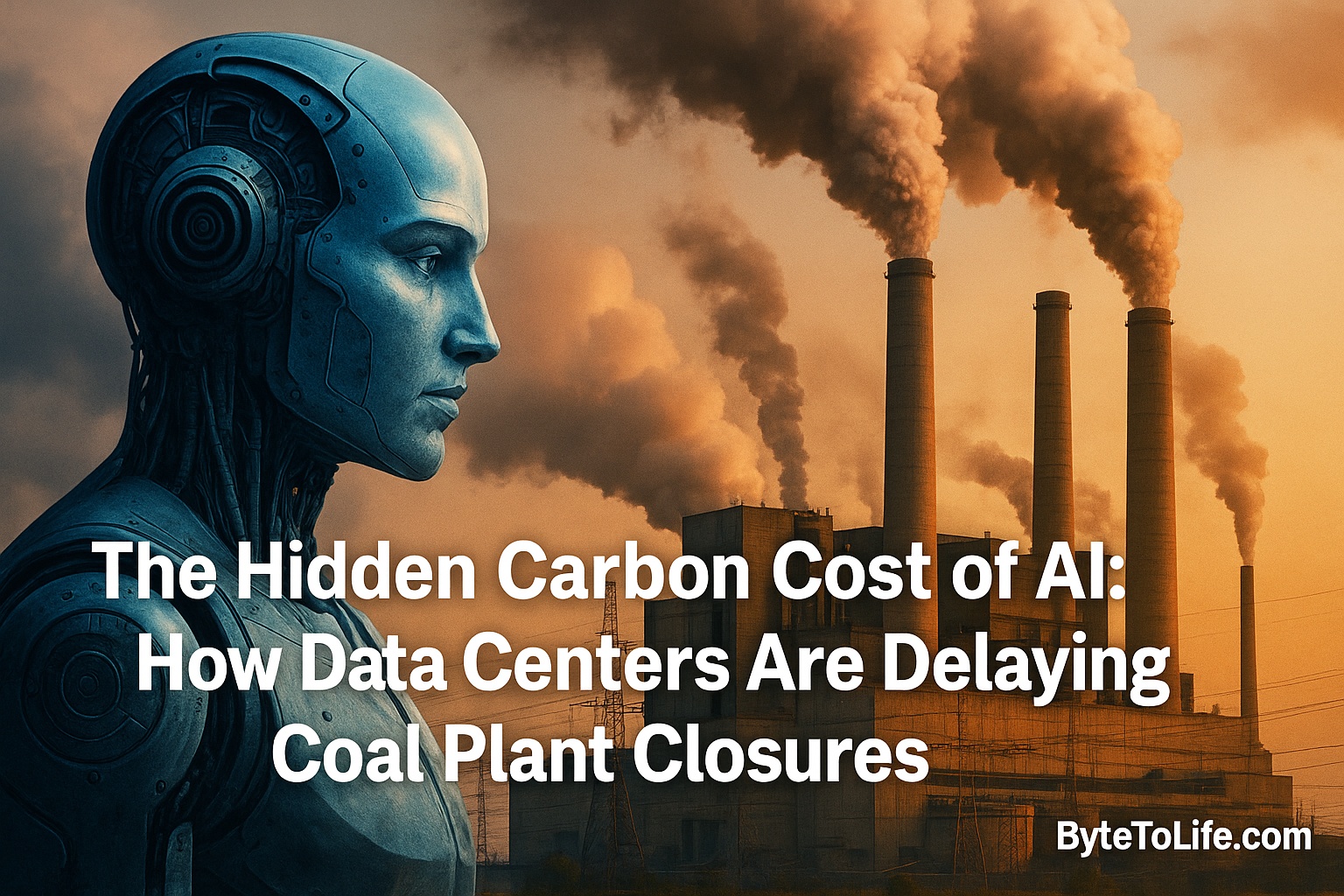Artificial Intelligence (AI) is widely celebrated for its transformative impact across industries. From enabling real-time language translation to powering medical diagnoses and fueling autonomous vehicles, AI is reshaping how we live and work. However, the growing use of powerful AI models has introduced a less-discussed consequence: a massive increase in energy demand. In the United States, this surge has contributed to a surprising and alarming trend—utilities are delaying the closure of coal-fired power plants to keep up with the energy requirements of sprawling AI data centers.
While AI holds enormous potential for innovation and efficiency, its deployment at scale comes with real environmental costs. Understanding the energy implications of this technology is critical to ensuring that our digital future is also a sustainable one.
The Data Center Boom: Fueling AI’s Growth
Behind every AI model is a complex web of servers, storage devices, and cooling systems housed in massive data centers. These facilities serve as the backbone of modern computing, processing and storing the vast volumes of data needed to train and deploy AI systems. Over the past few years, demand for AI-driven services has exploded, prompting tech giants like Google, Microsoft, Amazon, and Meta to rapidly build new data centers across the U.S.
However, building and operating these data centers requires enormous amounts of electricity. Most are connected to regional power grids, and in areas where renewable energy infrastructure is underdeveloped, fossil fuels like coal and natural gas remain the primary sources of electricity. As a result, the energy-hungry expansion of data centers is threatening progress on climate commitments.
Case Examples Across the U.S.
- Kansas City: In response to increased power demands from new data center projects, local utilities postponed the retirement of aging coal plants that were slated to shut down by 2024.
- West Virginia: Officials acknowledged that the state’s energy grid was unprepared for a sharp rise in demand, forcing regulators to delay the phase-out of coal facilities.
- Salt Lake City: Salt Lake City has adjusted its clean energy transition schedule after AI infrastructure developments raised concerns over grid stability.
Why AI Needs So Much Power

AI models are becoming more complex and resource-intensive. Large Language Models (LLMs) like GPT-4 or Gemini consist of billions of parameters and require vast computational resources to train. These training processes can run continuously for weeks or months, consuming megawatt-hours of electricity. But the energy consumption doesn’t end with training—AI models must be deployed across servers to handle real-time queries from millions of users, a process known as inference, which also consumes significant energy.
How Much Energy Is Too Much?
- Training GPT-3 reportedly consumed as much electricity as 120 U.S. homes use in a year.
- AI inference can use up to 10 times more energy per request than a standard Google search.
- According to the IEA, data centers and AI may account for 8% of total global electricity demand by 2030.
The Climate Trade-Off: Coal Over Clean?
Many U.S. states and cities had committed to ambitious plans for retiring coal plants and investing in renewable energy. However, the surge in AI-driven demand has complicated those goals. When renewable energy supply cannot keep pace, utilities are left with no choice but to prolong the use of existing fossil fuel infrastructure. This backsliding undermines local and national targets for reducing greenhouse gas emissions.
It’s a harsh paradox: the very technology that could help model climate change and improve efficiency in other sectors is, in some cases, directly contributing to the problem it seeks to solve.
Ethical and Economic Dilemma
Finding equilibrium between advancing AI and protecting the environment remains a significant challenge. Should AI deployment be slowed until green energy catches up? Should governments place limits on data center energy use? These issues are intricate and lack straightforward solutions.
Moreover, the economic stakes are high. Data centers bring investment and jobs to local communities, making them politically attractive. But the environmental costs are often externalized and long-term. The communities that suffer the most from extended coal plant operations are typically already vulnerable to pollution-related health problems.
Voices from the Industry
Industry leaders are aware of the dilemma. Sam Altman, CEO of OpenAI, has emphasized that scalable AI will require breakthroughs in energy production, particularly in nuclear and clean energy. Google, Meta, and Amazon have also committed to sourcing carbon-free energy for their operations by 2030. However, many climate experts argue that these timelines may not be fast enough given the urgent need to cut emissions this decade.
Paths to a Greener AI
Despite the challenges, there are promising strategies for reducing AI’s carbon footprint:
- Smaller, optimized models: Researchers are developing lightweight AI models that require less computation and power.
- Green data centers: Facilities powered by wind, solar, hydro, or geothermal energy can dramatically lower emissions.
- On-device AI: Processing data locally on user devices reduces reliance on power-hungry cloud servers.
- Policy solutions: Governments can incentivize energy-efficient AI development and penalize excessive emissions.
The Role of Consumers and Developers
Consumers and developers can play a part in shaping a more sustainable AI ecosystem. Choosing platforms and tools that prioritize efficiency and transparency can shift the industry’s direction. Developers can contribute by using open-source libraries optimized for energy usage, and consumers can support companies that report their carbon footprints and invest in green energy.
Looking Ahead: Building Sustainable AI
As we stand at the intersection of digital transformation and environmental urgency, the choices we make now will define the long-term relationship between AI and the climate. It’s clear that we must rethink how we build and power the infrastructure behind AI. From better policy and investment in renewables to more responsible consumption and development practices, there is a path toward a greener AI future—but only if we act decisively.
Global Impact and Geopolitical Ramifications
The environmental effects of AI are not confined to the United States. Worldwide, countries are grappling with how to balance AI adoption and sustainability. In regions where coal or natural gas is still a primary energy source, rapid AI deployment may reinforce dependence on fossil fuels.
Moreover, energy-intensive AI development could deepen global inequality. Wealthy nations may dominate AI infrastructure while lower-income countries struggle with emissions burdens caused by data outsourcing and hosting services. This imbalance could provoke calls for international agreements or carbon taxes related to global AI operations.
The Economics of Energy-Hungry Intelligence
Running AI systems is not only energy-intensive but also expensive. Rising electricity costs are a concern for companies building and maintaining large-scale models. These costs could be passed on to users, increasing the price of AI-enabled tools and applications.
Startups and smaller developers may find it difficult to compete in this landscape, resulting in greater market concentration among tech giants. That raises antitrust concerns and may hinder diversity in innovation. Making energy-efficient AI accessible will be critical to a healthy digital economy.
Regulation and the Road Ahead
Several governments and international bodies are beginning to explore regulations aimed at mitigating AI’s environmental impact. For example, the European Union has proposed energy labeling and sustainability reporting for digital services. In the U.S., certain states are exploring tax incentives for green data centers and penalties for emissions-heavy operations.
Future regulations could include:
- Mandatory energy disclosures for AI models above a certain size
- Caps on electricity use per model or service
- Audits and certifications for “green AI” compliance
AI for Climate Good: A Dual Approach

Paradoxically, the same technology causing environmental concerns can also be part of the solution. AI has the potential to revolutionize climate science, help monitor deforestation, optimize energy grids, and accelerate green technology innovation.
Here are some positive uses of AI in the environmental space:
- Predictive Modeling: AI helps forecast climate patterns, assess risk, and optimize disaster preparedness.
- Smart Agriculture: AI enables precision farming that reduces water, fertilizer, and pesticide usage.
- Wildlife Monitoring: Computer vision and machine learning detect poaching, track endangered species, and map biodiversity.
FAQ: Frequently Asked Questions
1. Why is it that AI systems require so much energy?
AI systems—especially large models like GPT, Gemini, and LLaMA—require powerful hardware such as GPUs and TPUs to process vast amounts of data. Both the training and inference (running) phases use significant electricity, especially when deployed at global scale.
2. How are AI data centers linked to coal plant closures being delayed?
As AI usage grows, energy demand surges. In areas where renewable infrastructure isn’t yet sufficient, utilities rely on fossil fuels—often coal—to meet demand. To ensure grid stability, some regions are postponing the retirement of coal power plants.
3. What companies are involved in building these energy-hungry data centers?
Major tech firms such as Google, Microsoft, Meta (Facebook), Amazon, and Nvidia are among the primary drivers of large-scale data center expansion to support AI workloads.
4. Are there sustainable solutions for powering AI?
Yes, organizations are turning to sustainable data center solutions driven by renewable sources like wind, solar, and geothermal energy. There are also efforts to create smaller, more efficient models and promote on-device AI processing that doesn’t rely heavily on centralized servers.
5. Is AI helping or harming the environment overall?
Both. While AI can optimize energy grids, monitor climate patterns, and support green innovation, it can also accelerate emissions if deployed irresponsibly. The impact depends on how we manage the balance between benefits and energy costs.
6. What can consumers do to support greener AI?
Consumers can support platforms that disclose and reduce their carbon footprint, use open-source or lightweight tools, and advocate for sustainable tech policies. Every choice—from using eco-efficient apps to asking for transparency—can influence the AI ecosystem.
7. Will future regulations limit AI development due to its environmental impact?
It’s possible. Several regions are exploring sustainability rules for digital services, including AI. These may include mandatory emissions reporting, energy caps, or incentives for green infrastructure. The goal is to ensure progress without sacrificing the planet.
Final Thoughts: Aligning AI with Sustainability
The rise of AI has arrived, and its acceleration shows no signs of slowing down. But if we hope to align progress with the planet’s well-being, we must embed sustainability into every layer of AI development—from hardware design to model training, deployment, and end-user applications.
This isn’t just a technical challenge—it’s a societal one. It requires cooperation among governments, companies, developers, and users. Only with a shared commitment can we ensure that the intelligence we create serves not just our convenience but also our collective future.
Continue Learning
- AI in Interior Design: Smart Home Aesthetics
- DeepSeek AI: Next-Level Productivity
- How AI Tools Are Transforming Office Tasks in 2025
- Agentic AI: The Rise of Autonomous Digital Workers
- Nature: Energy and Policy Impacts of AI
Want more content like this? Visit ByteToLife.com for expert insights on AI, cybersecurity, and digital sustainability.
Bookmark ByteToLife.com to stay ahead with actionable, ethical, and innovative content on the future of tech.



